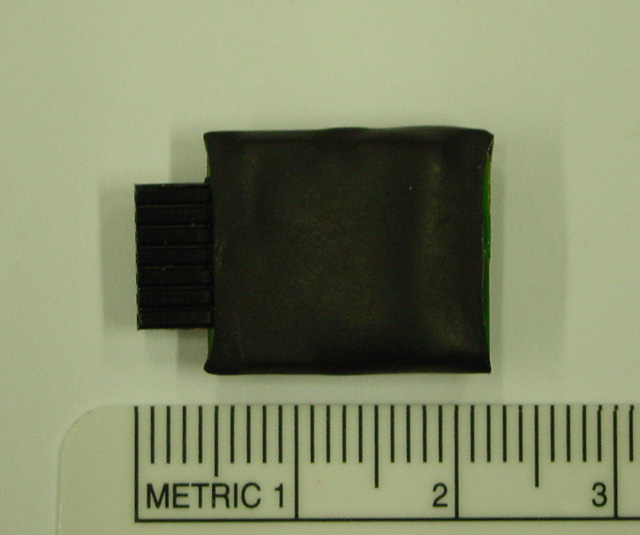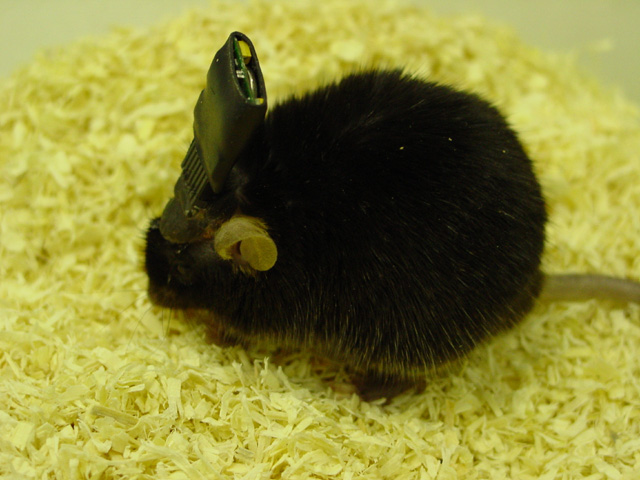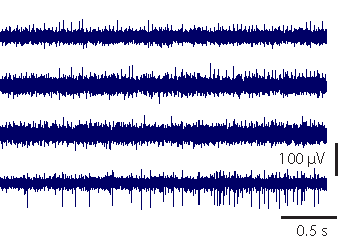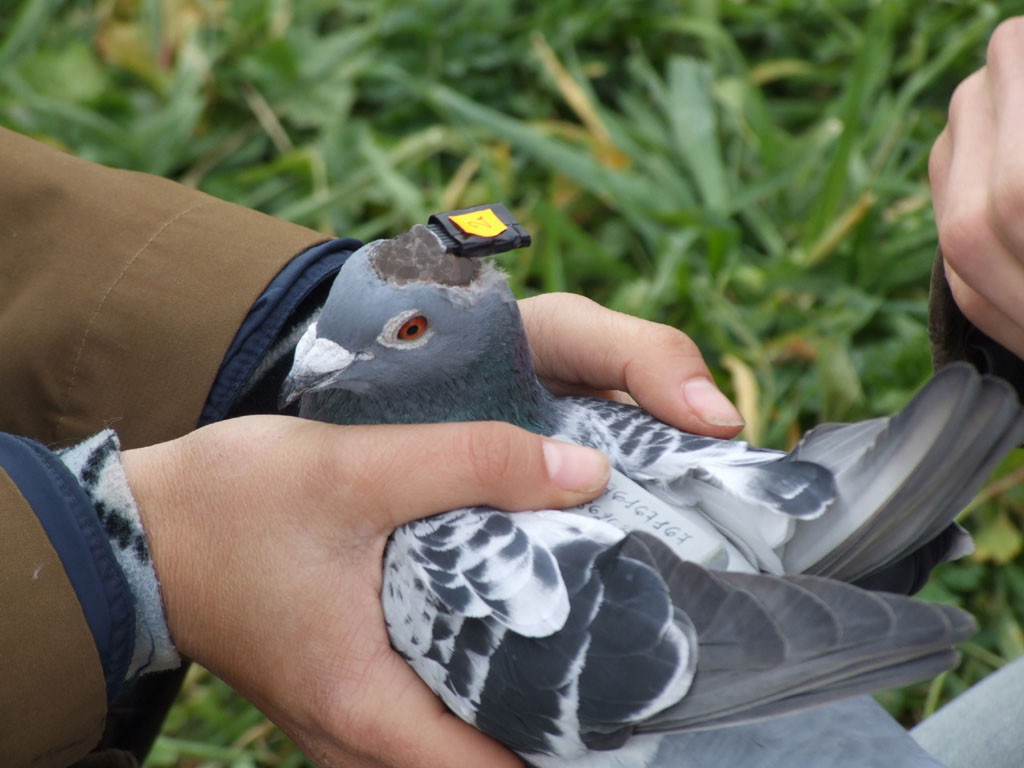|
Neurologger 2/2A/2B
Neurologgers of the second generation were designed to record a large set of biological variables (up to 4 analog channels) in their large integrated memory (1 GB or 2 GB), having size and weight suitable for attachment to a head of a mouse or a back of a zebra finch (small song bird weighing 14-17 g). The minimal weight of recording module including two ZA5 35 mAh batteries is 1.3 g, the size is 22×15×5 mm.
Neurologger 2A can record:
- EEG (electroencephalogram)
- LFPs (local field potentials)
- Neuronal activity
- EMG (electromyogram)
- ECG (electrocardiogram)
- Animal vocalizations below 9.6 kHz
- 3-D acceleration
- Event labels for precise synchronization with external equipment
Neurologger 2B has been designed to record high-frequency and ultrasonic vocalizations in animals. It records:
- Animal vocalizations, frequencies below 16.6 kHz, 4 channels
- Animal ultrasonic vocalizations, frequencies below 100 kHz, 1 channel
- 3-D acceleration
- Event labels for precise synchronization with external equipment
Neurologger can be implanted to record brain activity, for instance, in large ruminants, or it can be placed in a rigid protective waterproof casing to record in marine environments. Just ask!
Recently developed 3D head orientation tracking micro-board for Neurologger 2A/2B incorporates 16-bit 3D accelerometer, 3D gyroscope and
3D magnetometer.
An additional 24-bit pressure sensor helps to determing
altitude, for instance,
in a freely-flying bird.
24-bit thermometer can catch even tiny fluctuations of ambient temperature.
Neurologger 2A has been used in the recent publications:
Perinot et al., 2024
Conners et al., 2024
Ba et al., 2024
van Hasselt et al., 2024
Chen et al., 2024
- In Nature Communications!
Zaid et al., 2024
Sotelo et al., 2023
van Hasselt et al., 2023
Tossell et al., 2023 - In Nature Neuroscience!
Yu et al., 2022 - In Science the 2nd time!
Miracca et al., 2022
Zaid et al., 2022
Johnsson et al., 2022
Harding et al., 2021
Johnsson et al., 2021
van Hasselt et al., 2021a
van Hasselt et al., 2021
van Hasselt et al., 2020b
Conelly et al., 2020
Aulsebrook et al., 2020
Padovani et al., 2020
Yu et al., 2020
van Hasselt et al., 2020a
van Hasselt et al., 2020
Ma et al., 2019
Gent et al., 2019
Allocca et al., 2019
Yu et al., 2019
Delotto et al., 2019
Yu et al., 2019 - In Nature Neuroscience!
Tisdale et al., 2018
Müller et al., 2018
Harding et al., 2018
Gent et al., 2018
Gelegen et al., 2018
Nair et al., 2018
Scriba et al., 2017b
Müller et al., 2017
Tisdale et al., 2017
Scriba et al., 2017a
Franklin et al., 2017 - In Nature Neuroscience!
Nair et al., 2016
Uygun et al., 2016
Rattenborg et al., 2016
- In Nature Communications!
Zhang et al., 2016
Yu et al., 2015 - In Neuron!
Shine et al., 2015
Zhang et al., 2015 - In Nature Neuroscience!
Yu et al., 2014
Anisimov et al., 2014 - In Nature Methods!
Backer et al., 2014
Scriba et al., 2014
Voirin et al., 2014
Amendola et al., 2014
Gelegen et al., 2014
Zhan et al. 2014 - In Nature Neuroscience!
Duriez et al. 2014
Scriba et al., 2013b
Scheffzük et al., 2013
Scriba et al., 2013a
Zecharia et al., 2012
Lesku et al., 2012 - Finally in Science!
Brankack et al., 2012
Scheffzük et al., 2011
Previous modification Neurologger 2
has been used in the following studies:
Brankack et al., 2010
Pang et al., 2009
Vyssotski et al., 2009
Rattenborg et al., 2008
Neurologger is a registered trademark.
Protected by U.S. patents #8,160,688;
#9,492,085; #11,134,864.
Other patents pending.
|
Attention current Neurologger 2 users!
The latest version of Downloader utility is
Ver. 2.03 (21.10.2023)
Now utility converts data to
European Data Format (EDF)
Please update if you have an earlier version.
NEW: Neurologger with optional 3D accelerometer, 3D gyroscope and 3D magnetometer that allow
3D animal head orientation tracking.

Built-in IR receiver is used not only for synchronization with external erquipment,
but also for remote ON/OFF of Neurologger and optiogenetic stimulation control.

Neurologger 2A with remote ON/OFF and configuring by the magnet for implantation
in marine animals.
LED flash confirms operation success.

Neurologger 2/2A/2B

Neurologger 2 on a mouse

Neurologger 2A for recording ECG
in marine birds

Neurologger 2B for recording ulrasonic
vocalizations in bats (200 kHz sampling)

An example of Neurologger 2 neuronal record
(tetrode in the nidopallium of a homing pigeon)
|

Neurologger 2 on the head of a homing pigeon
|

Neurologger 2 on the head of a homing pigeon.
GPS logger is attached at the back
|
Technical data of the Neurologger 2A/2B
Number of channels: |
4 with 2 ref. inputs
(ch1 and ch2 to ref1; ch3 and ch4 to ref2) |
ADC resolution: |
10 bit |
Input range is factory-adjustable. Typical ranges are: |
+/- 500 µV for EEG
+/- 1 mV for neuronal activity
+/- 3 mV for LFPs
+/- 6 mV for ECG |
Neurologger mechanical dimensions (without batteries): |
22x15x3 mm 3 |
Total mechanical dimensions (Neurologger, batteries): |
22x15x5 mm 3 |
Weight of 1GB neurologger board: |
0.945 g |
| Weight of two 80mAh Renata ZA10 batteries: |
0.635 g |
| Weight of head connector: |
0.255 g |
Weight of protective cover: |
0.170 g |
Weight of battery connecting wires: |
0.050 g |
Total weight: |
2.055 g |
Battery life time: |
EEG logger, 4 channels,
100, 200 or 400 sps |
1 day 9 h |
|
Single unit logger, 4 ch x 9.6 ksps |
23 h |
1 GB memory data filling time: |
4 channels, 100 sps |
20 days 17 h |
|
4 channels, 200 sps |
10 days 8 h |
|
4 channels, 400 sps |
5 days 4 h |
|
4 channels, 1600 sps |
1 day 7 h |
|
4 channels + 3D accelerometer, 100 sps |
13 days 19 h |
|
4 channels + 3D accelerometer, 200 sps |
6 days 21 h |
|
4 channels + 3D accelerometer, 400 sps |
3 days 10 h |
|
4 channels + 3D accelerometer, 1600 sps |
20 h 42 min |
|
4 channels, 9.6 ksps (with or w/o 3D accelerometer) |
5 h 10 min |
|
4 channels, 19.2 ksps (with or w/o 3D accelerometer) |
2 h 35 min |
|
4 channels, 33.3 ksps (with or w/o 3D accelerometer) |
1 h 29 min |
| 1 channels, 200 ksps (with or w/o 3D accelerometer) |
59 min 39 s |
1 GB data downloading time: |
27 min 2 s |
Interface: |
3 SPI, 8Mbps, converted to USB via custom adapter, power supply, one CMOS digital input for events recording (shared with SPI pin) |
Data format: |
Custom |
Neurologger 2A/2B versus Neurologger 2
"Neurologger 2A/2B" has the same size and weight as "Neurologger 2", but it encapsulates a set of improvements. The most significant are:
-
Memory size is increased from 256 MB to 1GB . Version with even larger 2GB memory can be assembled by request.
-
Downloading speed in increased 1.8 times in the first Neurologger 2A releases and 3.6 times starting from firmware 7.12. Now the downloading baud rate is 8 Mbps against original 2.2 Mbps.
-
Maximal sampling rate has been doubled in version 2A and increased 3.47 times in version 2B. Sampling rate can be freely chosen between 0.6 Hz and 19.2 kHz in version 2A and between 61 Hz and 33.3 kHz in version 2B. In addition, version 2B can record single channel data with a sampling rate up to 200 kHz.
- Oversampling 1x, 2x, 4x or 8x can be freely chosen to increase accuracy of analog-digital conversion. In Neurolpogger 2 oversampling was fixed: 8x for 100 Hz mode and 4x for 200 Hz and 400 Hz modes. However, the primary sampling rate can't exceed the maximal rate 19.2 kHz (or 33.3 kHz in version 2B).
Additionally, the accelerometer add-on micro-board to record 3-D acceleration (or its absolute value) has been developed. The maximal sampling rate for the acceleration is 1 kHz, the default resolution is 8 bits. A 12-bit acceleration data can be stored if needed. Having weight of 0.442 g only, the add-on board also incorporates the infrared receiver to get the synchronizing signal from the external equipment sent through “Neurologger Synchronizer”. Acceleration and synchronization can be stored together with four neuronal channels sampled upto 19.2 kHz (33.3 kHz in version 2B).
|

|

